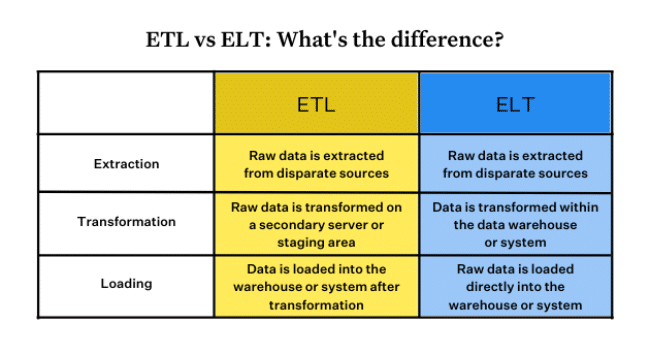Table of Contents
ETL (Extract, Transform, Load) and ELT (Extract, Load, Transform) are standard information-processing methodologies in statistics manipulation. Both intend to transport information from one region to another, commonly from a supply device to a data warehouse or facts lake. However, the vital thing distinction lies in the collection of operations. Understanding the nuances between ETL vs ELT Is critical for organizations seeking to make informed picks approximately their data technique. This article investigates the significant varieties of ETL and ELT, their separate benefits and downsides, and rules on picking the correct procedure for your boss.
ETL: Extract, Transform, Load
ETL represents Concentrate, Change, and Burden, and it’s been the customary methodology for records mixing for a long time. In ETL, facts are first extracted from numerous source systems. This data can come from databases, programs, or other records repositories. Once extracted, the records undergo transformation processes to ensure it’s far in the best layout and shape for the goal device. This transformation phase can include information cleaning, aggregation, and enrichment. After transformation, the information is loaded into the goal facts warehouse or records mart. ETL is specifically beneficial when coping with legacy structures and based information, because it guarantees statistics first-class and consistency earlier than loading.
ELT: Extract, Load, Transform
ELT, then again, stands for Extract, Load, Transform. This technique is more modern and has received a reputation with the advent of current statistics garage and processing technology. In ELT, information is first extracted and then straight away loaded into the target device, including a data lake or cloud-based statistics warehouse. The transformation happens after the information is loaded, leveraging the processing strength of the goal system. ELT is especially advantageous while coping with huge volumes of raw and semi-based statistics, as it allows for more flexible and scalable information processing. This method can extensively lessen the time required to get data into the hands of analysts and choice-makers.
Advantages and Disadvantages of ETL
One of the primary benefits of ETL is the capacity to make sure information is first-class and consistency earlier than loading it into the goal gadget. By remodeling the facts earlier than it’s far loaded, companies can cope with facts problems early within the technique. This is particularly crucial for corporations that depend on correct and reliable records for their operations. Additionally, ETL processes may be custom-designed to satisfy particular enterprise wishes. However, ETL also has its drawbacks. The transformation segment can be resource-intensive and time-eating, doubtlessly slowing down the complete manner. Moreover, ETL may additionally need help with the scalability required for dealing with massive datasets, making it less suitable for modern big records environments.
Advantages and Disadvantages of ELT
ELT gives numerous advantages, particularly within the context of cutting-edge facts architectures. By leveraging the processing energy of current information warehouses and cloud structures, ELT can successfully handle significant volumes of records. This approach also allows extra agile and flexible records processing, as adjustments may be performed on-demand and changed as wished. Furthermore, ELT can simplify records workflows by reducing the want for intermediate garage and processing levels. However, ELT has its challenges. The technique calls for strong goal structures that manage complex differences and huge information volumes. Additionally, ensuring facts satisfactory post-load may be extra hard, as issues most effectively become evident after the records are already within the system.
Choosing the Right Approach for Your Organization
Deciding between ETL and ELT relies upon on numerous elements, including the nature of your statistics, the abilities of your statistics infrastructure, and your particular commercial enterprise needs. ETL can be the higher choice if your business enterprise offers dependent statistics from legacy structures and calls for stringent information and excellent controls. Alternatively, if you are operating with massive volumes of raw or semi-based facts and need a scalable, bendy solution, ELT can be more appropriate. It’s also vital to remember your facts team’s capabilities and knowledge, as ETL and ELT require exceptional technical processes and toolsets. Ultimately, ETL and ELT choices must align with your company’s average facts method and goals.
ETL Versus ELT
ETL and ELT are each essential methodologies for records integration, with their strengths and weaknesses. ETL gives strong data quality and consistency, making it perfect for established data and legacy systems. In comparison, ELT leverages present-day statistics processing technologies to address massive volumes of facts extra correctly, presenting greater flexibility and scalability. Understanding the differences between these methods and their advantages and disadvantages is essential for making knowledgeable choices about your records approach. By carefully comparing your employer’s needs and talents, you may choose the approach that satisfactorily helps your desires and maximizes the fee of your facts.
Read more on KulFiy
